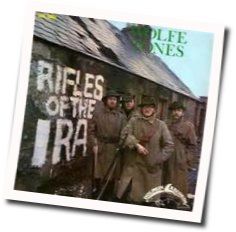
One of the few representations of this cultural group is Bessie Burgess in the Sean O'Casey play The Plough and the Stars. It is this Loyalist working class of both religions who the composer is confronting in the song. Supporting this tradition was the existence of a relatively large, and now generally forgotten and disappeared, Dublin Protestant working class. The rest of Ireland was policed by the militarily organised Royal Irish Constabulary, a form of gendarmerie, whereas Dublin had its own police force, the Dublin Metropolitan Police, which was a civilian force similar to that found in any large British city. The relative loyalty of Dublin is emphasised by its policing. This tradition continued long after Irish independence.

Dublin continued to elect unionist politicians and voluntary service in the British Army was a popular career choice amongst working-class Dubliners, both Catholic and Protestant. It was only with the arrival of Protestant settlers in Ulster in the Plantation of Ulster of the 17th century that the north of Ireland became an alternative centre of loyalism to Britain. For centuries, Dublin was the centre of The Pale, an area fully under control of the Crown, even when England had little control of the rest of Ireland. While the title of the song refers to the Black and Tans of the War of Independence era, the specific context of the song is a dispute between Irish republican and loyalist neighbours in inner-city Dublin in the 1920s. The song ties Irish nationalism to the struggles of other peoples against the British Empire across the world. When the commemoration was announced, a Wolfe Tones spokesperson used the band's official Twitter account to condemn it, stating the Black and Tans "murdered and terrorised our country 100 years ago".įollowing the cancellation and news of their song's iTunes charting, the spokesperson tweeted: "Fine Gael got their answer.The lyrics are rich with references to the history of Irish nationalism and the activities of the British Army throughout the world. Taoiseach Leo Varadkar said the event had become "very divisive", but said he hoped it could take place at a later date. The minister said: "I do not believe that the event, as planned, can now take place in an atmosphere that meets the goals and guiding principles of the overall commemorative programme." The Black and Tans became hate figures in Ireland for their brutal tactics, including the original 'Bloody Sunday' killing of 14 people during a Gaelic football match at Dublin's Croke Park in 1920.Įarlier this week, members of Dublin City Council voted to boycott the commemoration, prompting Mr Flanagan to cancel it. Members of the Royal Irish Constabulary's 'Black and Tans' being inspected in the early 20th century. Irish Justice Minister Charlie Flanagan had described the event as a "modest and solemn commemoration", but it was cancelled following criticism from the public and politicians, including Sinn Féin president Mary Lou McDonald, who described it as "crass Fine Gael revisionism gone too far".

The event was due to take place in Dublin Castle on January 17 as part of the Republic's Decade of Centenaries.

The song's appearance pushed contemporary releases by the likes of Maroon 5 and Lewis Capaldi down the charts, and members of the Wolfe Tones attributed it's appearance to a planned commemoration in Dublin for the Royal Irish Constabulary and Dublin Metropolitan Police.


 0 kommentar(er)
0 kommentar(er)
